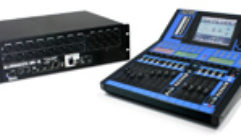
Mackie TT24
Jun 1, 2005 12:00 PM,
By John McJunkin
Digital console provides an analog feel for live sound.
Digital consoles provide us with a number of desirable and powerful conventions not available in their analog counterparts. As with most audio equipment, they found favor in the studio world prior to enjoying acceptance in sound reinforcement. Now that digital consoles have matured and found approval in the live sound world, more manufacturers are making offerings. Mackie’s TT24 is the latest digital live sound console to appear and is proving to be a solid product at a very attractive price. Mackie’s engineers have worked hard to make this digital console feel as “analog” as possible. Let’s take a look.
The TT24 has 24 analog and 24 digital channel inputs. The 24 digital inputs are available at the 44.1kHz or 48kHz sample rate, but only 12 digital inputs are available at 96kHz, unless an OPT24t expansion card is used.
Each analog channel input has both mic (XLR) and line (1/4in. balanced/unbalanced TRS) inputs, along with a TRS insert. All 24 of the analog inputs have a gate, compressor, and four-band EQ. The console also features eight analog line (1/4in. balanced/unbalanced TRS) inputs, one stereo RCA CD/tape input, and one stereo 1/4in. balanced CD/tape input. An additional XLR mic input is featured for a talkback mic.
In terms of output, the TT24 also has three (left, right, center/mono) balanced XLR main outputs, 12 1/4in. balanced/unbalanced TRS auxiliary sends, one stereo RCA CD/tape output (fed by the mains), and three 1/4in. balanced TRS outputs to drive monitors at FOH. The console also features eight male XLR connectors. These normally represent the outputs of groups one through eight, but when the TT24’s matrix mixer is active, they can each represent distinct mixes of any number of input sources.
The digital I/O section features three ADAT optical I/O pairs, AES/EBU, and S/PDIF in and out. Word clock in and out, MIDI in and out, and a USB port are also featured. There are two expansion card slots intended to accept the aforementioned OPT24t card — or the U100 card, enabling the linking of two TT24s for 96-channel/48-fader operation; the UFX2 card, providing four additional effects processors or 24 channels of DSP for the digital inputs; or the LP48 card, with EQ and loudspeaker processing featuring DSP from Lake Technology.
The TT24’s control surface features 24 channel strips, each with a mic/line input toggle switch; 48V phantom power switch; mic/line gain control; LEDs to indicate overload and signal presence; a V-pot rotary encoder; Mute, Select, and Solo buttons; and a 100mm motorized fader. A 15-segment LED ring surrounds each V-pot for visual display and metering.
There are four Bank buttons above and to the right of the channel strips that determine which bank of inputs the channel strips are currently controlling. The Analog and Digital buttons enable control of their corresponding inputs. The Returns button renders control over the returns bank — channels 1 through 8 corresponding to the eight analog line inputs, channels 9 through 16 corresponding to the unit’s four internal stereo effects returns, and channels 17 through 24 corresponding to return channels from any expansion cards. The Master button enables control over various master levels — channels 1 through 12 corresponding to the 12 auxiliary send masters; channels 13 through 20 corresponding to the eight group masters; and channels 22 through 24 corresponding to the left, right, and center/mono main outputs.
The V-pots can control pan, trim, meters, HPF, auxiliary sends 1 through 12, and auxiliary pan (for stereo-linked sends only). The pan and trim functions are self-explanatory, as are the auxiliary send and auxiliary pan functions. The HPF function allows the V-pot to control an 18dB/octave HPF by pressing the V-pot knob and to adjust cutoff between 20Hz and 400Hz by turning the knob. The meters function toggles between signal level and gain reduction displays with a press of the V-pot knob.
The TT24 features a QuickMix control section with a touchscreen and a matrix of 12 knobs that control many channel parameters, including a FAT button, which displays an overview of all settings and metering for any given channel. Some parameters are not controllable from the overview screen, but touching a non-adjustable parameter on the screen opens the control screen for that parameter, enabling adjustment. The EQ, DYN, GRP/AUX, and AUX MSTR buttons open the control screens for their corresponding parameters. The Snap button displays and enables editing of the console’s snapshots. The EFX buttons open and enable control over the console’s four internal effects processors (including delay, reverb, chorus, and flange). The Matrix button opens the matrix mixer to allow very flexible signal routing and mixing. Finally, the Engineer’s Utility section contains setup, utility, copy, and paste controls. There are LED meters for left, right, and center/mono channels, along with Mackie’s Rude Solo LED. The section also provides controls for talkback, monitor, and headphone levels. There are four group strips and one master strip, each with a V-pot and Group Assign/Select, Group Solo and Mute, and Master Select buttons. A global Clear Solo button clears all soloed channels, and a PFL button toggles between PFL and AFL for all soloed channels.
Another key feature is the console’s Aux Mode button, which instantly turns the console into a dedicated monitor mixer, with the faders controlling auxiliary send levels and the four group faders acting as auxiliary masters. Mackie also includes software that enables control of the console remotely from a computer.
The console can operate in two modes: L/R+Mono (stereo with an independent mono output) or LCR (true LCR panning from the channels and busses). The master outputs each have linkable six-band EQ (low and high shelving, two parametric, and two kill filters for feedback elimination) and a compressor. Each auxiliary send also features the six-band EQ/compressor DSP. The eight VCA-style flex group channels have a four-band EQ and compressor each. Additionally, each of the eight matrix outputs can be delayed by as much as 600ms.
The TT24 looks and feels quite solid and appears to be roadworthy. Connections are easily made, and once they are made, it doesn’t take long to get the signal routed where you want it. It takes some time to grow accustomed to the TT24’s personality and operation, but no more so than any other comprehensively appointed console. You won’t want to attempt to mix a show without first spending some time getting the feel of the board. Once you do, however, navigating this console is pretty simple. For most applications, proper signal routing will be set up in advance and stored as snapshots, allowing the engineer to concentrate on the mix. The only thing that doesn’t feel perfectly analog about this console is the tiny bit of latency in the fader controls, which makes them feel a bit “squishy.” This is really only noticeable when executing abrupt and drastic level changes, which simply doesn’t happen often, if ever.
Generally speaking, this is a solid, sophisticated console with comprehensive EQ and dynamics processing. Bearing its price in mind, the TT24 provides a huge amount of functionality, and it should be considered by anyone in need of serious live sound mixing horsepower.
SPECIFICATIONS
Analog
Mic Pre Frequency Response ± 2dB 10Hz to 20kHz
Mic Pre Distortion <0.003% at 20dBu output, 20Hz to 20kHz
Equivalent Input Noise -128dBu
Residual Noise -103dBu (at 0dB gain)
Input Impedance:Mic input 2k, balanced
Line input 10k
Aux returns 10k
CD/tape inputs 10k
Output Impedance: L/R/C(mono) 150
Group/Matrix 150
Aux send, monitor 150
CD/tape output 600
Digital
Sampling Frequency 44.1kHz, 48kHz, 88.2kHz, 96kHz
DSP 32-bit floating-point resolution
Propagation Delay <3.8ms at 44.1kHz, <1.7ms at 96kHz
Frequency Response ±1dB, 10Hz to 20kHz (44.1kHz sample rate)
±2dB, 10Hz to 40kHz (96kHz sample rate)
±0.5dB, 14Hz to 27.5kHz (96kHz sample rate)
THD+N <0.02% at +4dBu input, 10Hz to 20kHz (44.1kHz); <0.03% at +4dBu input, 10Hz to 20kHz (96kHz)
Signal-to-Noise Ratio -78dBu (ref. +4dBu mic in to main out)
Dynamic Range 101dB (mic in to main out)
Crosstalk: Adjacent inputs -110dB at 1kHz
Adjacent main outputs -95dB at 1kHz
Adjacent aux outputs -115db at 1kHz
Physical Dimensions (H×W×D) 10.4″×42.6″×25″
Weight 71lbs.
AC Power Requirements 100VAC to 240VAC, 50Hz to 60Hz, auto-switching
PRODUCT SUMMARY
Company: Mackie; www.mackie.com
Pros: Analog feel. QuickMix touchscreen allows control of many parameters on any given channel.
Cons: Slight latency makes the fader controls feel a bit “squishy” during abrupt or drastic level changes.
Applications: Sound reinforcement in live sound environments.
Price: $7,199
John McJunkinis the principal of Avalon Studio Services in Phoenix and consults for both studios and live sound applications.








